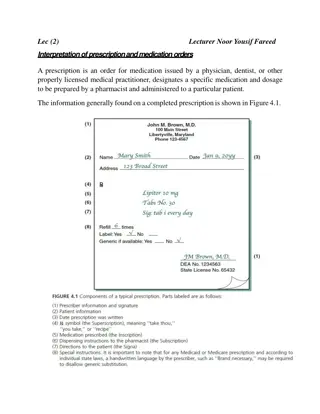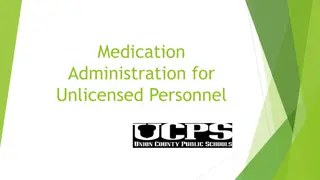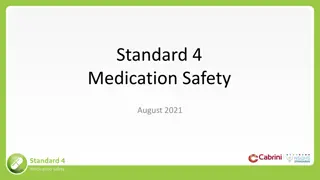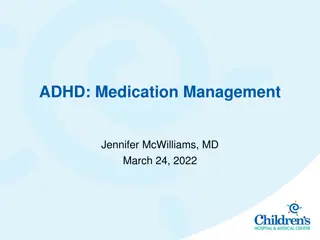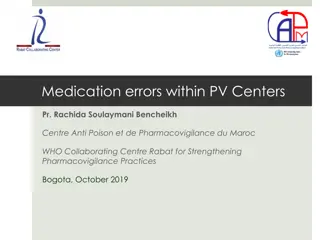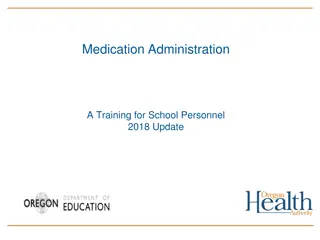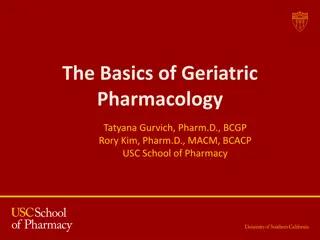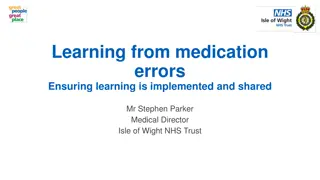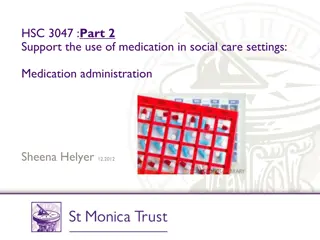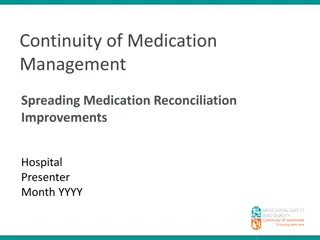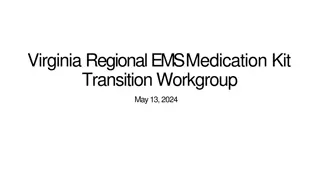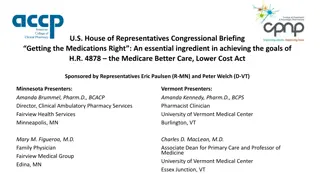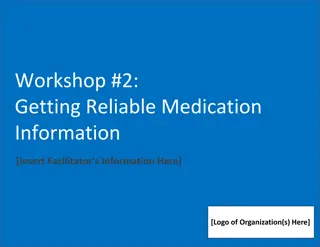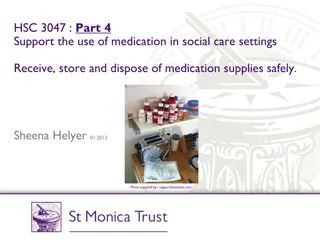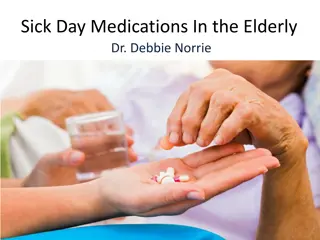
Ensuring Safe Administration of Medication in Children's Homes
Explore the regulations and standards for administering medication in children's homes, emphasizing the importance of proper handling, recording, and administration to ensure the well-being of the individuals receiving treatment. Learn about the guidelines for managing medicines and supporting children who self-administer their prescribed medication safely.
Download Presentation

Please find below an Image/Link to download the presentation.
The content on the website is provided AS IS for your information and personal use only. It may not be sold, licensed, or shared on other websites without obtaining consent from the author. If you encounter any issues during the download, it is possible that the publisher has removed the file from their server.
You are allowed to download the files provided on this website for personal or commercial use, subject to the condition that they are used lawfully. All files are the property of their respective owners.
The content on the website is provided AS IS for your information and personal use only. It may not be sold, licensed, or shared on other websites without obtaining consent from the author.
E N D
Presentation Transcript
Medication errors- practice review October 21st2021 Chris Freestone
working together confidentiality respect diversity of opinion can be enriching look for the benefits of an alternative opinion positive challenge na ve questions are valuable go off piste enjoy ourselves
aims To review the occurrence of medication errors in your service, look at causes , audit practice and carry changes forward
Focus areas the standards and regulations common errors why they occur factors influencing culture Self / your service - audit review and findings- part 2.
Starting point for today: Open discussion- context of the services represented Findings of your own reviews Analysing and informing practice going forward
Childrens Homes regulations and standards Administration of medicines 7.15 Please see regulation 23. Care must be taken to ensure prescribed medicines are only administered to the individual for whom they are prescribed. Medicines must be administered in line with a medically approved protocol. Records must be kept of the administration of all medication, which includes occasions when prescribed medication is refused. Regulation 23 requires the registered person to ensure that they make suitable arrangements to manage, administer and dispose of any medication. These are fundamentally the same sorts of arrangements as a good parent would make but are subject to additional safeguards. Where the home has questions or concerns about a child s medication, they should approach an expert such as a General Medical Practitioner, community pharmacist or designated nurse for looked-after children.
Childrens Homes regulations and standards 7.16 Children who wish to keep and take their own medication should be supported to, if they are able to do so safely. Staff should be mindful that children holding their own prescribed medication must only use it for themselves in accordance with the prescription. 7.17 Managing medicines in care homes (March 2014) is a guideline that applies across both health and social care
Regulation 23 23. (1) The registered person must make arrangements for the handling, recording, safekeeping, safe administration and disposal of medicines received into the children s home. (2) In particular the registered person must ensure that (a)medicines kept in the home are stored in a secure place so as to prevent any child from having unsupervised access to them; (b)medicine which is prescribed for a child is administered as prescribed to the child for whom it is prescribed and to no other child; and (c)a record is kept of the administration of medicine to each child. (3) Paragraph (2) does not apply to medicine which (a)is stored by the child for whom it is provided in such a way that other persons are prevented from using it; and (b)may be safely self-administered by that child.
Regulation contd (4) In this regulation, prescribed means (a)ordered for a patient, for provision to the patient, under or by virtue of the National Health Service Act 2006 or section 176(3) of the Health and Social Care (Community Health and Standards) Act 2003(1); or (b)in a case not falling within sub-paragraph (a), prescribed for a patient in accordance with regulation 217 of the Human Medicines Regulations 2012(2). (Managing medicines in care homes Social care guideline [SC1]Published: 14 March 2014. Last fully reviewed 2017. Coronavirus updates 2020)
Definition: A medication administration error (MAE) is defined as any difference between what the patient received or was supposed to receive and what the prescriber intended in the original order/ prescription.
Discussion: Having reviewed the errors , issues in your own services what were your findings ? Did you find : - Missed medication - Over/ under dosage - Lack of knowledge
Most common errors- findings from root cause analysis Wrong person surprisingly common . Omission- drug missed at the right time. Wrong time - delay, missed drug given too late. Prescribing- wrong drug , wrong dose, wrong type . Medications going missing Unauthorised drug. Administration errors including the incorrect route of administration, giving the drug to the wrong child, extra dose or wrong rate.
Other factors: - Adequate space - Time - Interruptions - Not enough staff - Staff not trained - Overwriting by staff - Taking telephone changes or instructions from parents or carers - Anything else??
Any common patterns? Why? Open discussion Using root cause analysis
Root Cause. A root cause is a factor that caused a nonconformance and should be permanently eliminated through process improvement. Root cause analysis is a collective term that describes a wide range of approaches, tools, and techniques used to uncover causes of problems. Sounds dire !!! Can t you tell it came from the car industry! Rephrased it means that:- -Root cause analysis is an approach for identifying the underlying causes of an incident so that the most effective solutions can be identified and implemented.
What do you do when you have a problem/incident/ accident / pattern at work? Do you jump straight in and treat the symptoms, or do you stop to consider whether there's actually a deeper problem that needs your attention? If you only fix the symptoms what you see on the surface the problem will almost certainly return, and need fixing over, and over again. Tracing a Problem to its Origins-
Root Cause Analysis (RCA) is a popular and often- used technique that helps people answer the question of why the problem occurred in the first place. It seeks to identify the origin of a problem using a specific set of steps, with associated tools, to find the primary cause of the problem, so that you can: Determine what happened. Determine why it happened. Work out what to do to reduce the likelihood that it will happen again. RCA assumes that systems and events are interrelated. An action in one area triggers an action in another, and another, and so on. By tracing back these actions, you can discover where the problem started and how it grew into the symptom you're now facing. Tracing a Problem to its Origins- the DSL
You'll usually find three basic types of causes: * Physical causes Tangible, material items failed in some way * Human causes People did something wrong, or did not do something that was needed. Human causes typically lead to physical causes * Organisational causes A system, process, or policy that people use to make decisions or do their work is faulty
Step approach RCA assumes that systems and events are interrelated. An action in one area triggers an action in another, and another, and so on. By tracing back these actions, you can discover where the problem started and how it grew into the symptom you're now facing. Step One: Define the Problem What do you see happening? What are the specific symptoms? Step Two: Collect Data What proof do you have that the problem exists? How long has the problem existed? What is the impact of the problem? ** There is no point looking for solutions until the problem is identified**
Step approach continued Step Three: Identify Possible Causal Factors What sequence of events leads to the problem? What conditions allow the problem to occur? What other problems surround the occurrence of the central problem? During this stage, identify as many causal factors as possible. Too often, people identify one or two factors and then stop, but that's not sufficient. With RCA, you don't want to simply treat the most obvious causes you want to dig deeper. DIG!! Use the 5 whys?? Use Ishikara Cause and effect diagrams- aka The Fishbone. Ask so what? Work with the team
Step approach continued.. Step Four: Identify the Root Cause(s) Why does the cause factor exist? What is the real reason the problem occurred? Step Five: Recommend and Implement Solutions What can you do to prevent the problem from happening again? How will the solution be implemented? Who will be responsible for it? What are the risks of implementing the solution? Analyse your cause-and-effect process, and identify the changes needed for various systems. It's also important that you plan ahead to predict the effects of your solution. This way, you can spot potential failures before they happen.
Follow on.or starting point- useful for the DSL Failure Mode and Effects Analysis (FMEA) Spotting Problems Before a Solution Is Implemented Asking the question - "What Could Go Wrong? This is particularly useful where high levels of risk are involved. You can use this when considering a high risk placement you identify what could go wrong and then look at the risk profile generated. Are these risks you can reasonably, safely mitigate? Impact Analysis Identifying the Full Consequences of Change. while doing the TRCA and identifying changes to made take a little time to think things through. If we do this how will it impact on ..? Avoid confusion and disruption later on and the I wish I had thought of that moment.
Root cause analysis- from problem- example Training Policies, procedures Up to date, fit for purpose. Up to date Competency based Clear , reviewed, known to staff Problem which has occurred Competency based Checks, processes procedures External audit Practice , processes CF.RCA.
Other factors to consider Equipment People in the broader sense Visitors Other professionals Environment Health and safety safeguarding
Now the uncomfortable bit in any RCA for the leader- You cannot assume . You have to : - THINK THE UNTHINKABLE- - Could it be deliberate - Do the drugs have a street value? - Could it be malicious - Could someone have fabricated illness think Beverley Allitt, think Sheffield Hospital scandal - Brainstorm it all.
Reduce errors. the right child, the right drug, the right dose, the right route, and the right time. These are the rights of ANYONE receiving medication
Reduce errors. A medication error is an error in the process of prescribing, dispensing, preparing, administering, monitoring or providing medicine advice, regardless of whether any harm occurred. Homes should have arrangements for reporting adverse events, adverse drug reactions, incidents, errors and near misses. If a young person is unwell as a result of the medication error or incident, or an error is noticed , medical assistance should be sought straight away. All notifiable incidents should be reported to Ofsted/ CSIW. Medication policies should include how to deal with medication errors, incidents and near misses.
Reduce errors Homes should have a clear reporting system for medication errors, incidents and near misses. There should be a regular schedule for investigating and reviewing medication errors, incidents and near misses by a designated member of staff with learnings and actions shared with all staff members involved with medicines. Any other thoughts?
Any queries? Please let me know of any questions or queries before we meet again. caf31.cf@outlook.com

